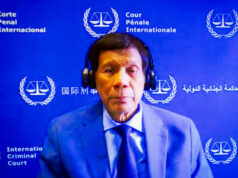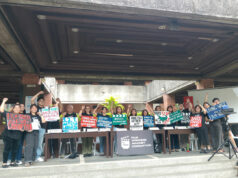US OKs $5.6-B jet deal with Philippines

By Kenneth Christiane L. Basilio, Reporter
THE US Department of State on Tuesday approved the possible sale of F-16 jet fighters and munitions worth $5.58 billion to the Philippines, a deal that could boost the Southeast Asian nation’s air combat capabilities amid rising tensions with China.
The US government greenlit the Philippines’ request for 20 units of F-16 fighters from Lockheed Martin Corp., according to the Defense Security Cooperation Agency (DSCA), an office attached to the US Defense department.
The proposed arms deal includes missiles, bombs, radar units, backup jet engines and engineering and technical support services for the planes, the DSCA said in a statement posted on its website. It has informed the US Congress of the potential deal.
Foreign military sales by US defense manufacturers require US government approval to ensure that weapon acquisitions of other nations align with Washington’s foreign policy and security interests.
The Philippine Defense department has yet to receive an “official notice” about the deal from the US, its spokesman Arsenio R. Andolong told BusinessWorld by telephone.
“This proposed sale will support the foreign policy and national security of the United States by helping to improve the security of a strategic partner that continues to be an important force for political stability, peace and economic progress in Southeast Asia,” the DSCA said.
The announcement comes days after the visit of US Defense Secretary Peter Brian Hegseth to Manila, during which he spoke with Philippine President Ferdinand R. Marcos, Jr. and Defense Secretary Gilberto C. Teodoro, Jr., vowing to help arm the US’ oldest treaty ally in Asia with deterrence capabilities by deploying advanced weaponry, such as an anti-ship missile system and unmanned sea vessels to counter China’s aggression in the South China Sea.
Philippine and US forces will also hold military drills in the northernmost province of Batanes island near Taiwan.
“The proposed sale will enhance the Philippine Air Force’s ability to conduct maritime domain awareness and close air support missions and enhance its suppression of enemy air defenses and aerial interdiction capabilities,” the DSCA said.
The deal could also help the Philippine military protect its “vital interests and territory” while also expanding interoperability with US forces, it added. “The Philippines will have no difficulty absorbing this equipment into its armed forces.”
Philippine forces have frequently sparred with Chinese ships and aircraft in the South China Sea over competing sea claims. Beijing asserts sovereignty over almost the entire waterbody based on its 1940s nine-dash line, which overlaps with territorial claims from the Philippines, Brunei, Malaysia, Taiwan and Vietnam.
A United Nations-backed tribunal based in The Hague in 2016 voided China’s claim for being illegal.
The Philippines is seeking to modernize its military and deepen security ties with other nations as it tries to counter China’s military might in the region, buying warships from South Korea, a missile system from India, all while letting a US missile battery that could hit the Chinese mainland stay in the country.
Manila is also eyeing much needed upgrades to its aging air force, whose arsenal mostly consists of turboprops. The Philippine Air Force only has 11 Korean-made FA-50 light fighter jets, its most advanced aircraft, after one crashed in early March.
The deal would advance the Philippines’ air defense capabilities, said Justin Keith A. Baquisal, national security analyst at FACTS Asia.
“The problem now is that our air defense primarily relies on FA-50s, so this is very necessary to add to the fleet mix,” he said in an X message.
CHEAPER DEALS
Maintaining the F-16 jets won’t be difficult for the Philippines due to the US’ sprawling supply chain, he added. “America’s supply chain is global… The logistics industry around it can be sourced from NATO (North Atlantic Treaty Organization) countries too,” he added, referring to the military coalition of European nations.
Mr. Teodoro last year said the military had allotted as much as $6.9 billion for the acquisition of 40 advanced military jets.
The Philippines should consider diversifying its planned purchase of multi-role fighter aircraft and not rely on one manufacturer if it could get cheaper deals with others, said Joshua Bernard B. Espeña, who teaches international relations at the Polytechnic University of the Philippines.
The cost of the F-16 deal could still decrease, according to the DSCA.
Philippine authorities should strike a balance in buying affordable jets with its air force’s need to seamlessly work with its allies, he said in a Facebook Messenger chat. “We also need to consider how these systems might become integrated into the AFP’s (Armed Forces of the Philippines) combat management systems at the operational level.”
“We shouldn’t just diversify our combat systems and assets for the sake of diversifying,” Mr. Baquisal said. “Our assets need to be interoperable too, and by and large the AFP uses US and US-allied equipment from South Korea and Israel.”
The US State Department approved the sale of a dozen F-16 jet fighters worth $2.43-billion to the Philippines in 2021.
Meanwhile, the chiefs of Philippine and Canadian military forces on Wednesday met in Manila, where they discussed ways to deepen security ties.
AFP Chief of Staff Romeo S. Brawner, Jr. met with Canada’s Chief of Defense Staff Marie Annabelle Jennie Carignan during her courtesy visit to Camp Aguinaldo, the military headquarters in the Philippine capital, according to an AFP statement.
Both reaffirmed their commitment to maintaining regional peace and pledged to continue joint military training drills.
“The visit underscored the AFP’s efforts to strengthen its defense ties with like-minded nations, and to solidify its shared commitment to regional peace and security,” the AFP said.
Manila and Ottawa last month finalized negotiations on a pact enabling military personnel from both countries to conduct joint training exercises in each other’s territories. It provides immunity from criminal and civil liability to visiting forces if the act was done during official duty. The privilege is also extended to Filipino soldiers visiting Canada.



